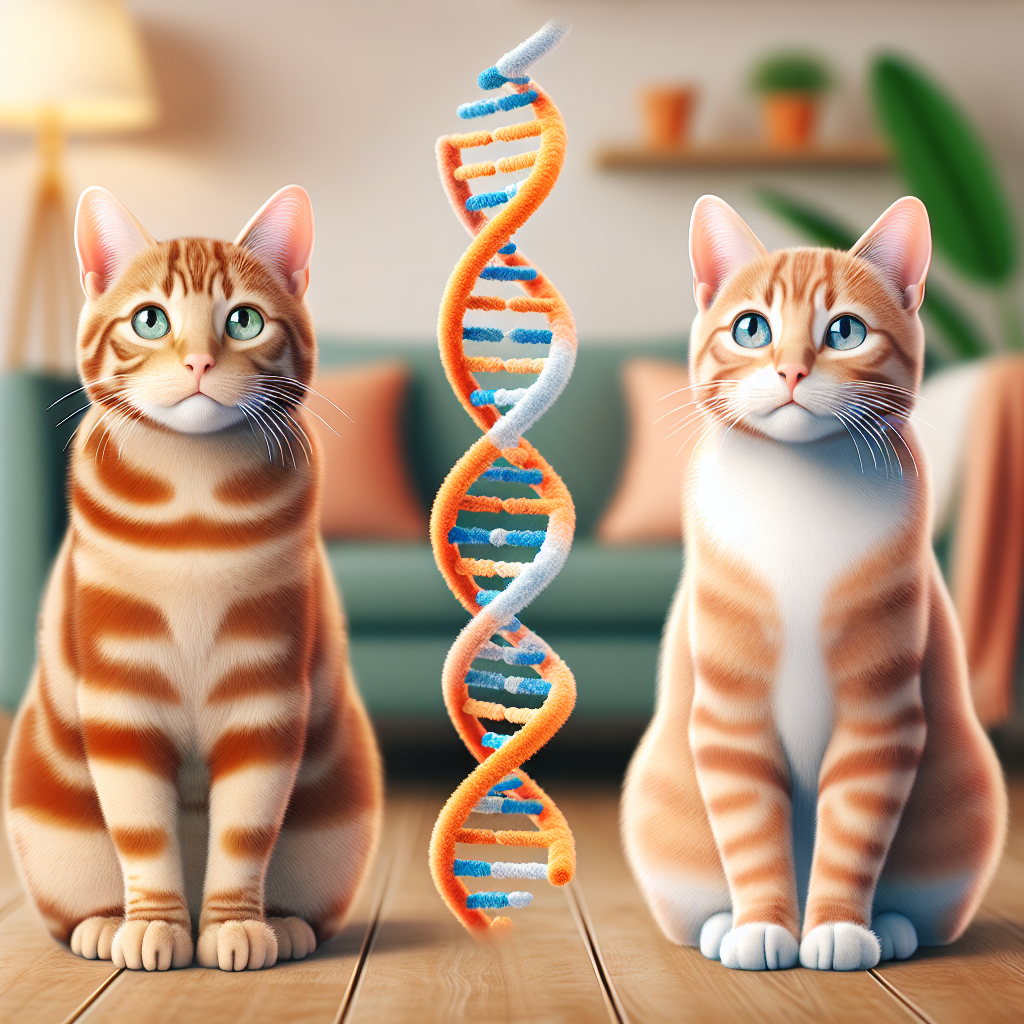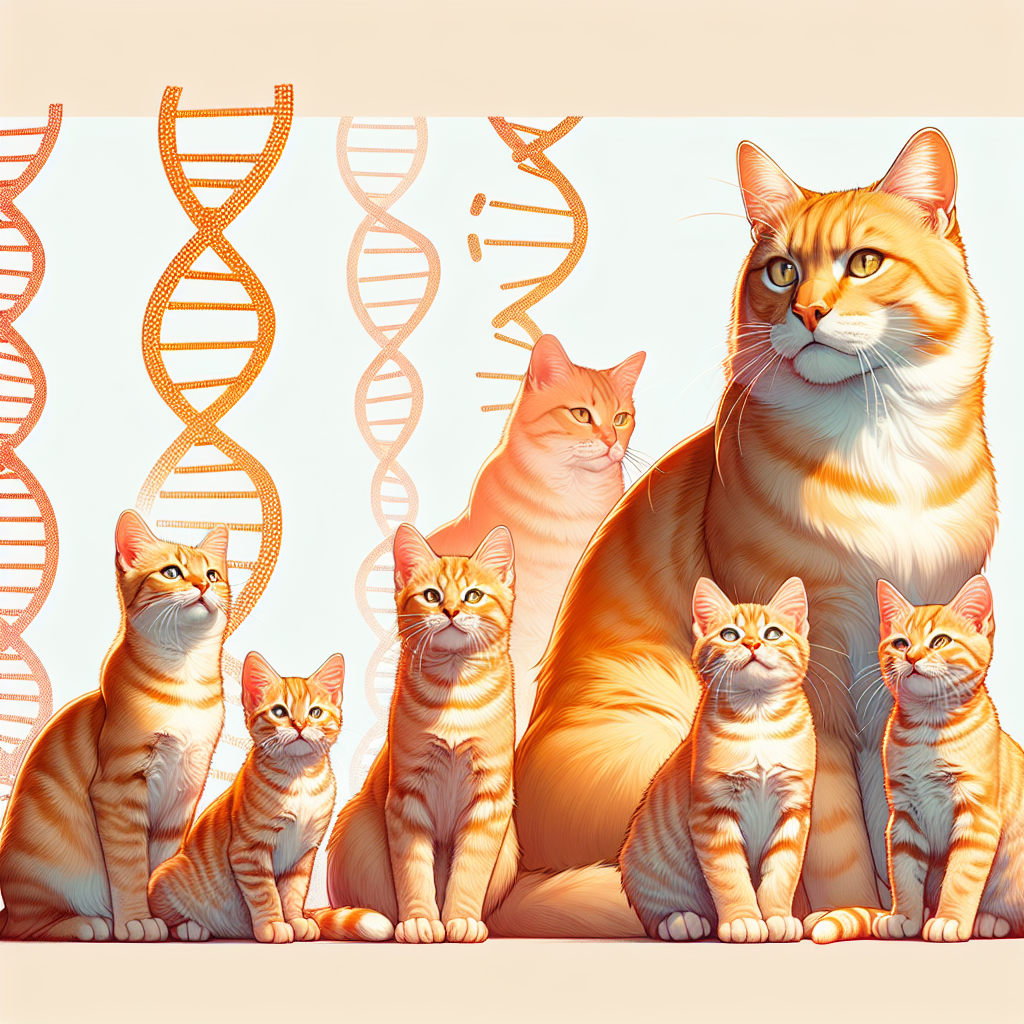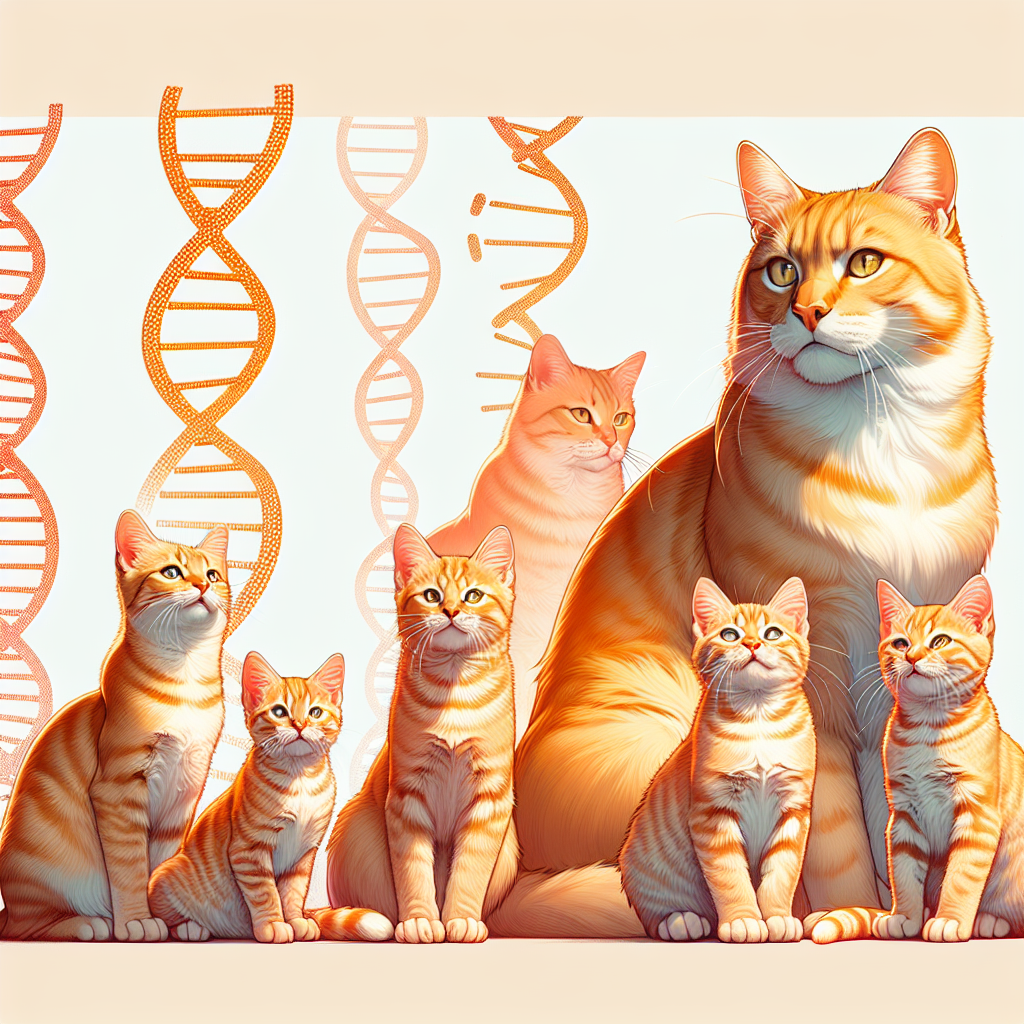Did you know that not all orange tabby cats are male? Contrary to popular belief, the color of a cat’s coat does not determine its gender. While it is true that most orange tabby cats are male, there are also female cats that sport this vibrant hue. The reason behind this common misconception lies in the genetics of cat coat colors. So, if you’ve ever wondered about the gender of that adorable orange tabby cat you encountered, read on to learn more about this fascinating topic.
What is an orange tabby cat?
An orange tabby cat refers to a specific coloration and pattern of a cat’s coat. These cats have a distinctive orange or reddish color and a striped or marbled pattern on their fur. Tabby cats, in general, have a pattern that resembles the letter “M” on their foreheads. However, orange tabbies are unique in their vibrant and eye-catching coloration.
Physical characteristics
Orange tabbies have a range of physical characteristics that make them easily recognizable. Apart from their distinctive orange hue, they often have white patches on their belly, chin, and paws. Their fur can be short or long, depending on the breed, and their eyes come in various shades of green, copper, or gold. The body structure of these cats can vary from slender to more muscular, depending on their breed.
Coat color variations
While orange tabbies are predominantly orange, there are variations in their coat color. Some may have lighter or darker shades of orange, and their tabby patterns can differ as well. These patterns may include classic tabby, mackerel tabby, spotted tabby, or ticked tabby. Each pattern adds a unique touch to their appearance, making them even more beautiful and captivating.
Personality traits
Orange tabbies are known for their friendly and outgoing personalities. They are often described as sociable, affectionate, and playful. With their curious nature, they tend to explore their surroundings and engage in interactive play with their owners. Orange tabbies are also known for being talkative and may express themselves through a wide range of vocalizations. They form strong bonds with their human companions and enjoy being the center of attention.
Gender determination in cats
Determining the gender of cats involves understanding their chromosomal makeup and the role it plays in determining physical traits, including coat color.
X and Y chromosomes
Cats, like humans, have chromosomes that determine their gender. Female cats have two X chromosomes (XX), while males have one X and one Y chromosome (XY). This chromosomal difference leads to variations in physical characteristics, including coat color.
Orange color gene
The gene responsible for the orange color in cat coats is located on the X chromosome. This means that cats with one orange gene on their X chromosome will have orange fur. If a cat has two orange genes (one on each X chromosome), their orange coloration may be more intense.
Role of sex chromosomes in coat color
The combination of sex chromosomes influences the coat color of cats. Female cats, with their two X chromosomes, may inherit an orange gene from one parent and a non-orange gene from the other parent. This can result in a mix of orange and non-orange patches, leading to a tortoiseshell or calico coat pattern.
Inheritance patterns
The inheritance of coat color in cats can become complex due to the involvement of multiple genes. Orange tabby cats can be produced by a combination of genes from both parents. The presence or absence of certain genes, as well as their interaction, determines whether an orange tabby is male or female.

Male orange tabby cats
Male orange tabby cats are more common than their female counterparts, and several factors contribute to this phenomenon.
Frequency of male orange tabbies
Approximately 80% of orange tabby cats are male, making them more prevalent in the feline population. This dominance of male orange tabbies can be attributed to genetic factors and hormonal influences.
Genetic factors
The inheritance of coat color genes plays a significant role in the higher occurrence of male orange tabbies. The gene responsible for the orange color is found on the X chromosome. Since males have only one X chromosome, they have a higher chance of inheriting the orange gene, resulting in their distinctive orange coat color.
Hormonal influences
Hormonal factors can also contribute to the prevalence of male orange tabbies. Male cats, specifically those with intact reproductive organs, produce more testosterone. This hormone has been linked to the development of the orange color gene expression in their fur, further enhancing their orange tabby appearance.
Temperament and behavior
Male orange tabby cats are known for their friendly and affectionate personalities. They often display a playful and outgoing nature, making them excellent companions. They are curious, social, and enjoy interactive playtime. Male orange tabbies are generally easygoing and tend to get along well with other pets and family members.
Female orange tabby cats
While male orange tabbies are more common, female orange tabby cats do exist, although they are less frequently seen.
Occurrence of female orange tabbies
Around 20% of orange tabby cats are female. They are less common due to the genetic factors associated with coat color inheritance.
Calico cats and coat color genetics
Female orange tabbies often exhibit a tortoiseshell or calico coat pattern. This is because the presence of two X chromosomes allows for a combination of orange and non-orange gene expression. The patches of orange, black, and white in their coat are a result of the complex genetic interplay involving multiple color genes.
Rare occurrence of female orange tabbies
The rarity of female orange tabbies stems from the fact that two orange genes are required for the intense expression of orange coloration. Since males have only one X chromosome, they need a single orange gene to exhibit the orange coat color. However, females, with their two X chromosomes, need both orange genes to have an intensely orange coat.
Fertility and reproductive challenges
Some female orange tabbies may experience fertility issues due to the complex genetics associated with their coat color. The presence of certain color genes linked to the orange coloration may be associated with other genetic factors that affect fertility. However, not all female orange tabbies experience reproductive challenges, as this can vary from individual to individual.

Factors influencing coat color in cats
Several factors contribute to the coat color of cats, including coat color genes, tabby pattern genetics, color dilution genes, and other genetic factors.
Coat color genes
The color genes inherited from both parents play a crucial role in determining the coat color of cats. These genes can include orange, black, yellow, and white, among others. The specific combination and expression of these genes result in the diverse coat colors seen among different cat breeds.
Tabby pattern genetics
The tabby pattern seen in orange tabby cats is also influenced by genetics. The genes responsible for the tabby pattern determine whether a cat will have a classic, mackerel, spotted, or ticked tabby pattern. These patterns combine with the orange color gene to create the distinct appearance of orange tabbies.
Color dilution genes
Color dilution genes can affect the intensity of coat color. For example, the presence of the dilute gene can result in a softer, lighter version of the orange color in tabby cats. This gene can give orange tabbies a more pastel or diluted appearance, altering their overall coat color.
Other genetic factors
In addition to the specific coat color genes, tabby pattern genetics, and color dilution genes, there may be other genetic factors at play that influence coat color in cats. The intricate interaction of various genes can lead to subtle variations in coat color among orange tabbies, making each cat unique.
Misconceptions about orange tabby cats
There are several misconceptions associated with orange tabby cats, primarily related to their gender, color preferences, and feline behavior.
Assumptions about gender
One common misconception is that all orange tabby cats are male. While male orange tabbies are more prominent, as explained earlier, female orange tabbies do exist, although they are less frequently encountered. It is essential to understand that coat color does not solely determine a cat’s gender.
Color preferences and stereotypes
Another misconception revolves around color preferences and stereotypes. Some people may wrongly assume that orange tabbies have specific personality traits based on their coat color. However, a cat’s behavior and temperament are determined by a combination of genetic factors, early socialization, and individual personality, rather than their coat color alone.
Feline behavior and temperament
It is important not to attribute specific behavioral traits solely to orange tabby cats. While they are often described as friendly and sociable, individual cats may exhibit a wide range of personalities, regardless of their coat color. Each cat, including orange tabbies, is a unique individual with their preferences and behaviors.
Other cat breeds with orange tabby individuals
Orange tabby cats are not limited to a specific breed. They can be found in various cat breeds, including:
Domestic shorthair
Domestic shorthair cats, which encompass mixed-breed cats, can have orange tabby individuals. Their genetic diversity allows for a wide range of coat colors and patterns, including the vibrant orange of orange tabbies.
Maine Coon
Maine Coon cats, known for their large size and tufted ears, can also have orange tabby individuals. The combination of the Maine Coon breed’s distinctive features and the eye-catching orange color makes these cats even more striking.
Persian
Persian cats, with their luxurious long coats and round faces, can also have orange tabby individuals. The combination of the Persian breed’s stunning appearance and the vibrant orange color creates an irresistible combination.
Abyssinian
Abyssinian cats, known for their ticked coat pattern and energetic personalities, can also have orange tabby individuals. The interplay between the Abyssinian breed’s coat patterns and the orange color creates a visually appealing cat.
Famous orange tabby cats
Throughout history, several famous orange tabby cats have captured the hearts of millions with their charm and lovable personalities. Some notable orange tabbies include:
Morris the Cat
Morris the Cat, known as the mascot for 9Lives cat food, was an orange tabby who captured the hearts of many with his distinct appearance and expressive personality. He became an iconic symbol of the brand and remains one of the most recognizable orange tabby cats in advertising history.
Garfield
Garfield, the beloved cartoon character created by Jim Davis, is another famous orange tabby cat. Known for his love of lasagna and his sarcastic wit, Garfield has entertained generations with his misadventures, making him one of the most popular orange tabby cats in pop culture.
Heathcliff
Heathcliff, created by George Gately, is a mischievous and street-smart orange tabby who has his comic strip and a television series. Heathcliff’s antics and larger-than-life personality have made him a beloved orange tabby character.
Orangey
Orangey, a talented orange tabby cat, had a successful career in Hollywood. He appeared in various films alongside famous actors and even won two Patsy Awards, the animal actors’ equivalent of an Oscar. Orangey’s notable roles include appearances in “Breakfast at Tiffany’s” and “Rhubarb.”
Caring for an orange tabby cat
Caring for an orange tabby cat involves providing the necessary grooming, nutrition, and healthcare to ensure their well-being.
Grooming and coat maintenance
Grooming an orange tabby cat depends on their coat length. Short-haired orange tabbies generally require regular brushing to minimize shedding and maintain a healthy coat. Long-haired orange tabbies may need more frequent grooming to prevent matting and tangling of their fur. Regular nail trimming, teeth brushing, and ear cleaning are also essential aspects of their grooming routine.
Nutritional considerations
Proper nutrition is crucial for the overall health of any cat, including orange tabbies. A balanced diet that meets their specific nutritional needs will help maintain a healthy weight and support their overall well-being. It is important to provide them with high-quality cat food that is appropriate for their age, activity level, and any specific health concerns they may have.
Health issues to be aware of
While orange tabby cats do not have specific health issues related to their coat color, they may be prone to certain breed-specific health concerns. Regular veterinary check-ups and preventive care, such as vaccinations and parasite control, are essential to ensure their ongoing health. It is also important to monitor their weight, dental health, and any signs of discomfort or illness.
Exercise and playtime
Orange tabby cats, like all cats, benefit from regular exercise and mental stimulation. Providing toys, scratching posts, and vertical spaces for climbing can help keep them entertained and engaged. Interactive play sessions with their owners, with a variety of toys and activities, can help satisfy their natural hunting instincts and keep them physically and mentally stimulated.
Adopting an orange tabby cat
If you’re considering adopting an orange tabby cat, there are various avenues to explore, including shelters, rescues, and breeders.
Shelter cats and rescues
Many orange tabby cats can be found in animal shelters and rescues, eagerly awaiting their forever homes. By adopting from a shelter or rescue, not only are you giving a loving home to an orange tabby, but you are also saving a life. These organizations work tirelessly to provide care and find suitable homes for cats in need.
Breeders and breed availability
If you have a specific cat breed in mind, some breeders specialize in breeding and raising orange tabby cats. It is essential to do thorough research and ensure that the breeder operates ethically and responsibly. Responsible breeders prioritize the health and well-being of their cats, as well as the welfare of the breed as a whole.
Considerations for adoption
When adopting an orange tabby cat, consider their specific needs, personality, and any potential challenges associated with the breed. Take the time to interact with the cat before adoption to ensure a good match. Adoption provides a wonderful opportunity to give a loving home to a deserving cat and make a lifelong impact on their well-being.
In conclusion, orange tabby cats are stunning and captivating creatures that bring joy and companionship into our lives. Whether male or female, these cats possess unique coat color genetics that contribute to their distinctive appearance. While male orange tabbies are more commonly seen, female orange tabbies also exist, albeit in smaller numbers. Understanding the factors influencing coat color genetics, debunking misconceptions, and providing appropriate care are essential aspects of being a responsible owner of an orange tabby cat. By adopting or welcoming an orange tabby into your life, you’ll be gaining a loving and loyal companion with an irresistible charm and a coat that is sure to turn heads.

